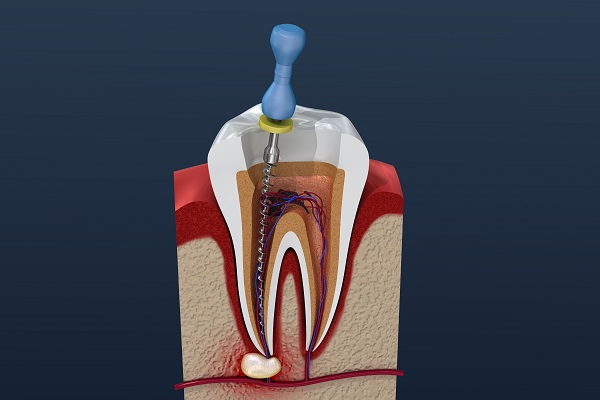How Is A Root Canal Performed?

Root canal therapy is commonly used in dentistry to remove infected or damaged tissues in a tooth's pulp chamber. The pulp chamber is located deep inside a tooth, and it houses connective tissues, nerves and blood vessels.
These soft tissues play an important role in the development and growth of teeth. They become less important when a tooth is fully grown, since the tooth can still be nourished by surrounding tissues.
A root canal is performed to remove a tooth's pulp once the area has been inflamed or infected. During the treatment, these soft tissues are extracted, then the tooth is filled with a material called gutta-percha. The procedure typically takes about an hour to treat a tooth, and there is no significant recovery period afterward. A tooth with a compromised pulp will lead to symptoms like persistent toothaches or the formation of an abscess under the tooth.
The root canal process
The first stage of getting a root canal involves the dentist examining the tooth so the patient's issues can be effectively treated. This might include diagnostic tests like x-rays and a visual inspection of the patient's tooth.
Once it has been determined that a root canal is the right course of treatment, the patient is then given a shot of a local anesthetic around the area being treated. A dental dam is placed on the tooth being treated so it remains dry during the procedure.
The dentist will then use a dental drill to open up the pulp chamber. Dental files are used to remove the soft tissues in the pulp chamber. The area is cleaned, disinfected and prepared for a filling. A biocompatible material called gutta-percha is used to seal the pulp chamber and keep bacteria away.
A temporary filling is then used to serve as an additional barrier protecting the tooth, and a crown might be used to protect the restored tooth. The patient might have to go without a crown for a few weeks while it is being made in a dental lab.
Root canals have a bad reputation as one of the most painful dental treatments a person can get, and that was once true. However, thanks to modern dental anesthetics, root canals involve little to no pain. These anesthetics give patients relief even before the treatment starts since they numb the damaged pulp that is causing pain. By the time the treatment is over, the source of the patient's toothache has been removed.
Recovery
There is no recovery period after getting a root canal, but patients should avoid doing things that can damage the newly restored tooth. Patients should stick to softer foods for the first few days after their treatment and avoid strenuous activities.
Get your tooth treated
Call or visit our Forest Hills clinic if you have a damaged tooth that needs a root canal. Our dentist will examine you and perform any necessary treatments.
Request an appointment here: https://metrosmiles.com or call Metro Smiles Dental at (718) 841-9591 for an appointment in our Forest Hills office.
Check out what others are saying about our services on Yelp: Read our Yelp reviews.
Related Posts
Whether you are missing a tooth or have a cracked tooth that needs repair, restorative dentistry can help. This article will discuss some of the most common dental restoration services available today.A tooth-colored filling, also known as composite resin, is made of plastic and can be used to replace decayed areas of teeth. The material…
Clear braces and other orthodontic advances make teeth straightening treatment more attractive to many patients. From clear aligners to ceramic braces, these innovative treatments allow patients to align their smiles without noticeable metal brackets and wires. Thanks to these alternatives, teeth straightening has become more accessible to those who want to avoid traditional metal braces.Traditional…
Cracked and chipped teeth can be unsightly and painful, but dental restoration can help. Even a painless chip or crack may become a bigger problem if left untreated. Severe pain, swollen and tender gums, and infection may result. In the worst cases, it will be necessary to extract the broken tooth. There are many ways…
You may need a type of dental restoration at some point in your life. There are many types of treatments available. Knowing how to select each one can give you the results that you need. Here are some tips on how to choose the right type of dental restoration procedure that will fit your dental…
